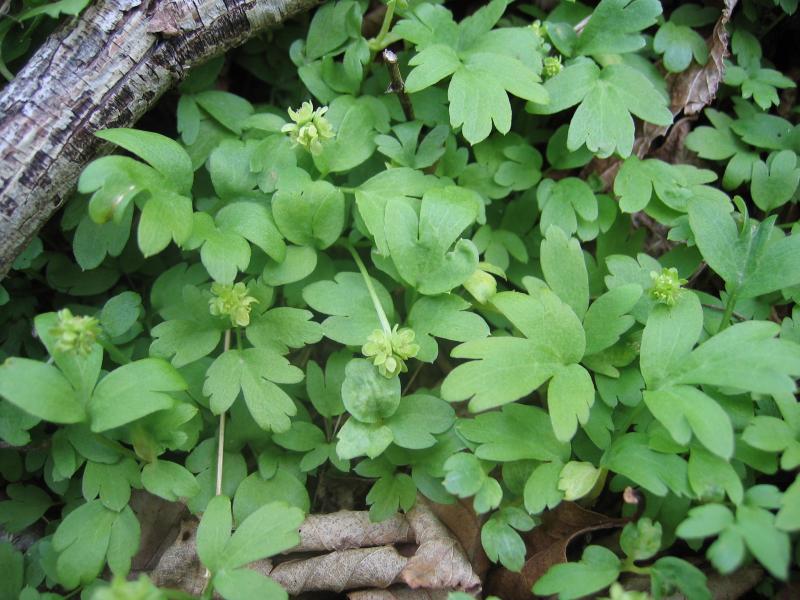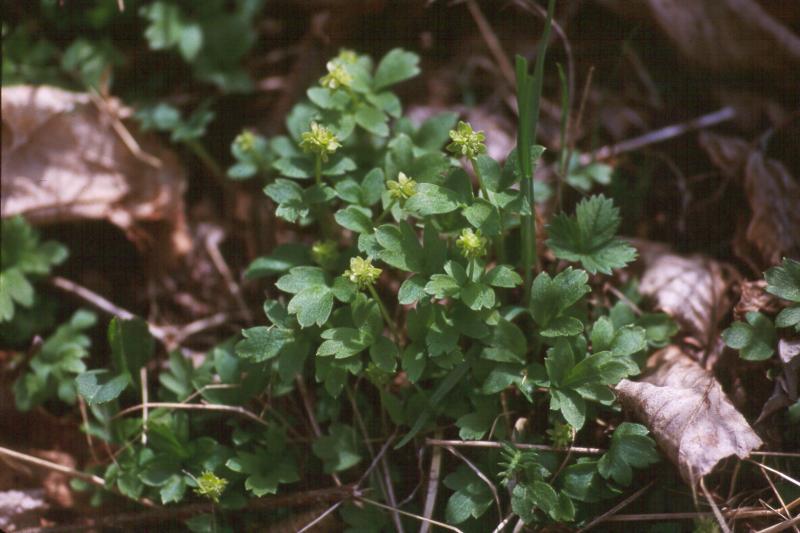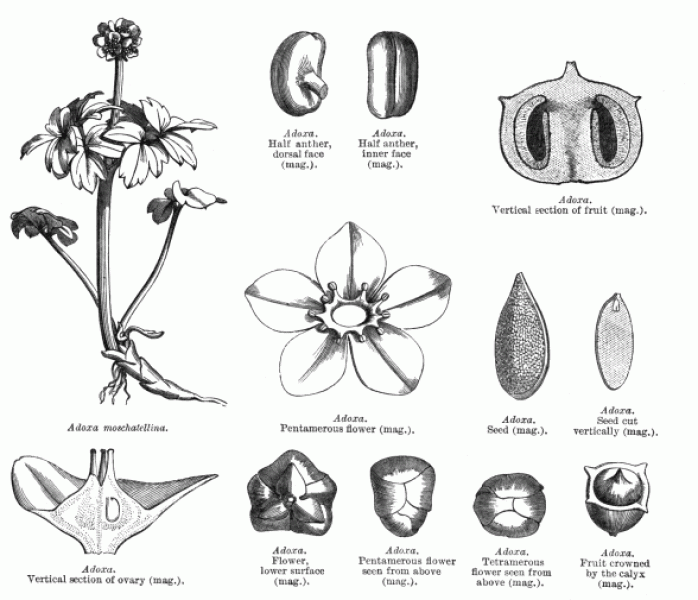Musk Root
Adoxa moschatellina L.
- Class
- Dicotyledoneae (Dicots)
- Family
- Viburnaceae
- State Protection
- Endangered
Listed as Endangered by New York State: in imminent danger of extirpation in New York. For animals, taking, importation, transportation, or possession is prohibited, except under license or permit. For plants, removal or damage without the consent of the landowner is prohibited.
- Federal Protection
- Not Listed
- State Conservation Status Rank
- S1
Critically Imperiled in New York - Especially vulnerable to disappearing from New York due to extreme rarity or other factors; typically 5 or fewer populations or locations in New York, very few individuals, very restricted range, very few remaining acres (or miles of stream), and/or very steep declines.
- Global Conservation Status Rank
- G5
Secure globally - Common in the world; widespread and abundant (but may be rare in some parts of its range).
Summary
Did you know?
New York populations of this plant are separated by appoximately one thousand miles from their closest known populations outside of the state. Considering that this plant is supposedly dispersed by snails, that is a long-distance road trip. The common name moschatel is French for "little musk" and refers to the musk odor of the flowers and roots (Fernald 1950). The Scottish picked up on the clock image that many see in the flowers of this plant. In Scotland, it is known as "Wee Toon Clock (small town clock) (Flora Celtica Database 2010)."
State Ranking Justification
Adoxa is limited in distribution to the Catskill Mountains where it is found on the fragile talus slopes, often near cold-air vents through the talus. Currently, there are three known populations that seem stable with no immediate threats. There are possibly up to ten populations within the Catskills, but finding this small plant is difficult.
Short-term Trends
This plant has a very limited distribution in New York. Many of the known and historical populations are within protected landscapes. Based on historical data and the well-protected landscapes, the short-term population trend is presumed stable. The projected short-term trend is also presumably stable.
Long-term Trends
As an uncommon plant with limited distribution found in areas not frequently surveyed, the long-term population trends are difficult to assess. To date, only one of the six historical populations have been rediscovered. More survey work is needed to follow-up on the remaining historical populations. As a small plant that may be easy to overlook, there is a good probability that these historical populations are still persisting. Despite minimal intensive survey efforts to find more populations of this plant, only two new populations have been discovered. This may support the idea that more populations are known than currently documented. With limited information the past population trend is presumed stable and the projected long-term population trend is also presumed stable.
Conservation and Management
Threats
This is a plant of cool climates and may be subject to global warming. Considering this plant is located near the cold air vents on talus slopes, a rather fragile community, any disturbance to the talus community undoubtedly will have an impact on the plants. At the same time, small scale natural disturances may be needed to maintain an open canopy. At this point, few invasive species are present in areas where this plant is found. As a result, the immediate threat from invasive species is rather low.
Conservation Strategies and Management Practices
As a plant already located within a relatively protected landscape, minimal management needs are necessary. If this plant is found in areas that receive significant recreational traffic, fencing may be recommended to limit access to the fragile talus slopes.
Research Needs
The impacts of global warming and deer browse are not known. Research activities to study these impacts would help us better understand the true threats to this plant. As a small plant difficult to see with potential habitat possibly throughout the Catskills, computer modeling to predict habitat and potential areas of occupancy could result in the discovery of undocumented populations.
Habitat
Habitat
A clump forming plant of moist rocks, often near the base of cliffs in rich woods, around cold air vents along lower portions of talus slope, on red sandstone ledges and hillsides, and in shallow soil on rock ledges (New York Natural Heritage Program 2004). Moist, often mossy places in forested regions (Gleason and Cronquist 1991). Mossy woods, wet rocks, etc. (Fernald 1970).
Associated Ecological Communities
- Acidic talus slope woodland
(guide)
An open to closed canopy woodland that occurs on talus slopes (slopes of boulders and rocks, often at the base of cliffs) composed of non-calcareous rocks such as granite, quartzite, or schist.
- Hemlock-northern hardwood forest
(guide)
A mixed forest that typically occurs on middle to lower slopes of ravines, on cool, mid-elevation slopes, and on moist, well-drained sites at the margins of swamps. Eastern hemlock is present and is often the most abundant tree in the forest.
- Ice cave talus community*
(guide)
A community that occurs on rocks and soil at the base of slopes of loose rocks (often below cliffs; these are talus slopes) that emit cold air. The emission of cold air results from air circulation among the rocks of the talus slope where winter ice remains through the summer. The vegetation is distinctive because it includes species characteristic of climates much cooler than the climate of the area where the ice caves occur.
* probable association but not confirmed.
Associated Species
- Acer pensylvanicum (striped maple)
- Aquilegia canadensis (wild columbine, red columbine)
- Aralia nudicaulis (wild sarsaparilla)
- Aster divaricatus
- Betula lenta (black birch)
- Betula populifolia (gray birch)
- Carex peckii (Peck's sedge)
- Clematis occidentalis
- Hydrophyllum virginianum
- Potentilla simplex (old-field cinquefoil)
- Pyrola elliptica (common shinleaf)
- Ribes cynosbati (prickly gooseberry, dogberry)
- Sambucus canadensis
- Sanguinaria canadensis (bloodroot)
- Saxifraga virginiensis
- Woodsia ilvensis (rusty woodsia, rusty cliff fern)
Range
New York State Distribution
There are three known populations and five historical locations all within the Catskill Mountains. These populations within the Catskills are disjunct and nearly a thousand miles from the next closest populations.
Global Distribution
A circumboreal plant of the upper Midwest and Canada extending south to southern Minnesota, Wisconsin, northern Illinois, and northern Iowa. There are disjunct populations in the Catskill Mountains of New York.
Identification Comments
General Description
Musk root is a small, delicate, musky-scented, perennial wildflower about 3-20 cm tall. The leaves at the base of the plant have leaf stalks longer than the blades. The blades are divided into three main lobes each containing 2-3 smaller lobes at the tip. There is one opposite pair of smaller stem leaves which are not as divided. Five flowers are usually borne in a tight cluster at the top of the stem. There are two kinds of small yellowish-green flowers; flowers on the outside of the cluster usually have five petals, while the ones in the middle have four petals. The small dry fruit has 4-5 seeds.
Identifying Characteristics
This is a delicate and small (3-20 cm tall) perennial with a musky odor. Its basal leaves have long petioles. These leaves are divided into three leaflets and each leaflet is 3-cleft or 3-parted. The yellow-green flowers are aggregated into a solitary terminal head. These small flowers (5-8 mm wide) are somewhat irregularly shaped. The terminal flowers are 4-merous and the lateral flowers are 5-merous. Some think the flower looks like the face of a clock. The rootstock is scaly and the plants are rhizomatous.
Best Life Stage for Proper Identification
Due to its small size, this plant is difficult to see at any time during the year. It may stand out most when in fruit or flower. However, you can identify it based on leaves alone.
Similar Species
This is an unusual plant that is the only member of its family (Adoxaceae). Recent genetic studies place it in close proximity to Sambucus and Viburnum (Caprifoliaceae), but Adoxa would not be confused with either genus.
Best Time to See
This is an early flowering plant with flowers appearing by early May. These flowers quickly give way to fruit. As an early spring flower, this plant often only persists into early summer. Ideally, surveys should be conducted in May.
- Vegetative
- Flowering
- Fruiting
The time of year you would expect to find Musk Root vegetative, flowering, and fruiting in New York.
Musk Root Images
Taxonomy
Musk Root
Adoxa moschatellina L.
- Kingdom Plantae
- Phylum Anthophyta
- Class Dicotyledoneae
(Dicots)
- Order Dipsacales
- Family Viburnaceae
- Order Dipsacales
- Class Dicotyledoneae
(Dicots)
- Phylum Anthophyta
Additional Common Names
- Common Moschatel
- Lady's Mantle
- Moschatel
- Wee Toon Clock (Scottish name)
Additional Resources
Best Identification Reference
Gleason, Henry A. and A. Cronquist. 1991. Manual of Vascular Plants of Northeastern United States and Adjacent Canada. The New York Botanical Garden, Bronx, New York. 910 pp.
Other References
Fernald, M.L. 1950. Gray's manual of botany. 8th edition. D. Van Nostrand, New York. 1632 pp.
Holmgren, Noel. 1998. The Illustrated Companion to Gleason and Cronquist's Manual. Illustrations of the Vascular Plants of Northeastern United States and Adjacent Canada. The New York Botanical Garden, Bronx, New York.
Mitchell, Richard S. and Gordon C. Tucker. 1997. Revised Checklist of New York State Plants. Contributions to a Flora of New York State. Checklist IV. Bulletin No. 490. New York State Museum. Albany, NY. 400 pp.
New York Natural Heritage Program. 2010. Biotics database. New York Natural Heritage Program. New York State Department of Environmental Conservation. Albany, NY.
New York Natural Heritage Program. 2024. New York Natural Heritage Program Databases. Albany, NY.
Reschke, Carol. 1990. Ecological communities of New York State. New York Natural Heritage Program, New York State Department of Environmental Conservation. Latham, NY. 96 pp. plus xi.
Weldy, T. and D. Werier. 2010. New York flora atlas. [S.M. Landry, K.N. Campbell, and L.D. Mabe (original application development), Florida Center for Community Design and Research http://www.fccdr.usf.edu/. University of South Florida http://www.usf.edu/]. New York Flora Association http://newyork.plantatlas.usf.edu/, Albany, New York
Links
About This Guide
Information for this guide was last updated on: February 7, 2008
Please cite this page as:
New York Natural Heritage Program. 2024.
Online Conservation Guide for
Adoxa moschatellina.
Available from: https://guides.nynhp.org/musk-root/.
Accessed July 27, 2024.



